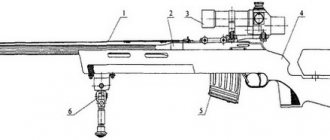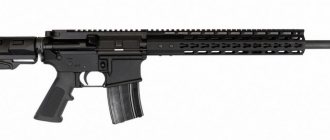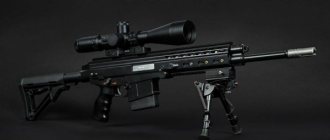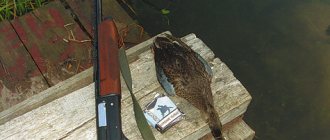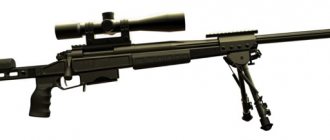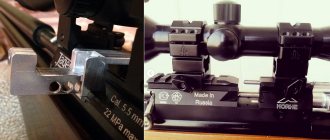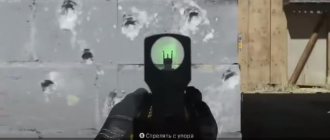Description
The Orsis-120 rifle is a rifled repeating carbine with a bolt action. The weapon is used for hunting fur and feathered game, catching small animals and even shooting predators. This versatility is due to the fact that the carbine is available in three different calibers:
- .223 REM (Remington) - 5.56x45 mm - used mainly for shooting small fur-bearing animals (hare, squirrel), as well as training and sports clay pigeon shooting;
- .243 Win (Winchester) - 6.2x52 mm - used for hunting larger fur-bearing animals (badger, fox), as well as for catching large game birds (grouse, black grouse);
- .308 Win (Winchester) - 7.62x51 mm - is used primarily for hunting medium-sized mammals (roe deer, deer), in rare cases - for shooting wolves.
As you can see, no old-fashioned ammunition like 7.62x39 and others. Only modern technologies were used in the production process. For example, the barrel is made of stainless carbon steel, and the rifling in it is made using the mandrel method. However, modernity is also inherent in the design of the weapon.
Design
It cannot be said that the Orsis-120 rifle was made completely from scratch. It successfully combines many design features characteristic of professional sporting, hunting and military weapons. Here are the most interesting of them:
- stock - wooden (walnut), half-pistol;
- stock - "Monte Carlo" with rear shock absorber;
- USM - adjustable, with double stroke;
- shutter - longitudinally sliding, smooth;
- fuse - three-position (fire, locking the striker and bolt);
- sighting rail - absent (installation of Weaver or Picatinny is possible);
- store - plastic, with a metal receiving hopper;
- sighting device is missing.
So no frills in the form of cheek pads, fiber optic front sights or muzzle compensators. The rifle has only what it needs to fire. However, the weapon has a wide base for modification and installation of various “body kits”.
Purpose
The Orsis-120 carbine was made for hunting medium-sized animals and small fur-bearing game. However, given the high accuracy of combat, as well as good range, the weapon can also serve as an excellent sniper rifle (subject to the installation of the appropriate body kit, of course). In some cases, a carbine can be used for sporting purposes, for example, if you choose a small-caliber variety and install a diopter sight on it. The most important thing is to have the desire and ability to modify.
Advantages and disadvantages
The Orsis-120 carbine has the makings of a high-quality rifle for hunting. At the same time, the weapon will not cost a fortune and will serve its owner faithfully for several decades. If this is not enough for you, then you can familiarize yourself with the advantages that customers speak about:
- High-quality protective coating Cerakote (matte, black). Thanks to it, the weapon is highly resistant to corrosion and mechanical stress.
- Protection from sun glare. The forend of the rifle has a fish scale notch. Although its area is not too large, it copes with its task.
- Adjustable trigger mechanism. Allows you to adjust the rigidity of the trigger “to suit you”, making its travel smoother.
- Simple and reliable shutter. It will not jam during reloading, and the likelihood of it getting caught on branches and bushes is reduced to almost a minimum.
- Convenient magazine latch design. It is located on the inside of the trigger guard, so the likelihood of accidental release is minimal.
- Good security system. It is presented in the form of a three-position fuse that blocks not only the trigger, but also the bolt frame.
Among the shortcomings, people mainly complain about the lack of certain systems that, in theory, should have been present in the Orsis-120. For example, a Monte Carlo stock without a pad can knock out a hunter's eye if he uses an optic. Well, the very absence of sighting devices perplexes some buyers who are accustomed to seeing front and rear sights on carbines.
Versions of "ORSIS-120"
As mentioned earlier, the Orsis-120 model is available in one of three calibers. The barrel channels of different rifles differ not only in their diameter, but also in the number of riflings. For example, .223 Rem and .243 Win have a pitch of 1:10. In the larger caliber .308 Win version, the bullet rotates every 11 inches of the barrel (1:11), which has a much better effect on the range of use.
Orsis carbine .308 Win
Don't forget about the optional versions of the Orsis-120 carbine. For example, in gun stores you can find models with a Picatinny rail already installed or with a thread at the end of the barrel, which allows you to install a muffler or muzzle constriction on the carbine. What can we say about the fact that a weapon can have a wide variety of under-barrel attachments: a laser target, a flashlight, a bayonet, and so on. True, the cost of such varieties of Orsis-120 is usually overpriced.
First Russian
Hunting carbine "ORSIS 120"
Surprisingly, despite all the sanctions and restrictions, the counters of many gun stores in terms of the range of imported weapons still, after a year and a half of this politicized circus, look very, very appetizing, offering hunters dozens of modern models of guns and carbines in a wide variety of designs . The exception, perhaps, concerns only American budget carbines, which in the USA cost $200–400 in empty configurations.
In pre-crisis times, American budget carbines cost from 25,000 to 35,000 rubles in Russia. and were in steady demand in all Russian regions. At the same time, we in the editorial office have repeatedly been convinced of the ability of all, without exception, inexpensive “Americans” to shoot perfectly, knocking out the notorious “minute” (about 3 cm at 100 m) with the selected factory cartridge. But even if the stocks of Remingtons, Mosbergs, Savages, Weatherrbys had not run out, their price, in full accordance with the dollar exchange rate, would no longer seem so “sweet” to us, having increased by 2.5–3 times.
By the way, it is the ruble price that has jumped significantly that is one of the reasons for the continued variety of foreign cars in stores - now few people have incomes that keep up with the growing dollar, and worries related to financial problems distract hunters from their hobby.
For the shooting test, we installed the domestic Pilad PV 3-9×42 L sight on the ORSIS 120, for which we also needed the Vologda rings. The sight costs about 12,000 rubles. and its characteristics are quite suitable for a budget weapon. Again, it is important that the complex turns out to be domestic. Shooting was carried out from a bipod mounted on the front swivel
In general, it remains to state a fact - the niche of carbines priced up to $1000 on the Russian arms market has become bare and, it would seem, an unplowed field is opening up here for domestic gunsmiths, who should have taken advantage of the situation yesterday. Not so. Our factories are taking too long to swing, they are being harnessed too slowly...
And yet, it finally happened - in a sense, the ORSIS 120 carbine suddenly appeared in stores at a price of less than 60,000 rubles. In St. Petersburg, the premiere of this model took place at the Bars weapons store, which traditionally offers hunters the most versatile range of weapons in terms of price range and set of brands. Together with Bars, we organized an introductory test of the new product at a shooting range using various cartridges.
Top down. The fuse is off (the “fire” position), the fuse is in the “discharge” position, the fuse is on. A cocked firing pin is identified tactilely by a protruding tang and visually by a red ring marking.
"ORSIS 120" is a classic hunting repeating rifle with a rotating bolt. It is now offered in two calibers (.223 Rem., .308 Win.) at the same recommended retail price of RUB 59,880. exclusively in a wooden walnut stock called (?). The promotional products also claim .243 Win., but so far it is not available in stores.
The seemingly modest set of calibers is in fact correctly optimized for the range of the most popular cartridges produced in Russia and suitable for both hunting and “shooting”. Ideally, I would like to see an inexpensive carbine also chambered for cheap 7.62x39 and 7.62x54 cartridges, but this wish is not a priority.
The barrel length in all calibers is 558 mm, which can be considered the optimal value for a universal carbine. The barrel is unusually massive at the breech for normal calibers and visually becomes very thin towards the muzzle. Most modern carbines have a muzzle diameter in the range of 17–19 mm, while the 120 model has a muzzle diameter of 16.3 mm. I think that this is due to the struggle to reduce the weight of the barrel, which is overweight at the base due to the use of a standard receiver from the Hunter model. You will find out whether this approach affected the quality of shooting from the results of our tests given in the article below.
Probably, many are interested in the manufacturing technology of the new barrel. After all, the ORSIS trademark is known primarily for the fact that it has facilities where mass production of high-precision planed barrels is realized using technologies used in the manufacture of individual products. The disadvantage of this technology is the high cost of the final product - the barrel, which itself is equal to the cost of the ORSIS 120 carbine. In addition, planing is focused on obtaining a shooting result that is absolutely unnecessary for the mass hunter, not because he is, let’s say, a bad shooter, but because in most hunts there are no conditions for the full realization of the capabilities of a weapon capable of driving a bullet into a bullet at a distance of 100 m.
Currently, the carbine is offered to hunters without mechanical sights and a mounting strip. , with which the weapon is shown in the picture, costs 5,800 rubles.
The logic in this case is quite simple. If the killing zone of game animals typical for Russian hunts (bear, elk, wild boar) is a circle with a diameter of 20–40 cm, and distances rarely (not always, of course) exceed 150 m, then the accuracy of the weapon is 10 cm (width per 100 m) guarantees that the target will be hit if the shooter acts correctly.
In general, there is nothing surprising in the fact that “ORSIS” in its “state budget” switched to mandrelization of barrels, which it tested on previously produced AR-15 carbines, which, by the way, fired quite competitively in comparison with foreign analogues with forged barrels.
The magazine release button is located inside the trigger guard
Through a hole in the trigger, the gun owner can adjust the pre-trigger force. True, access to adjustment without removing the stock is very difficult - a banal hole in the trigger guard would not hurt
The Model 120 bolt is equipped with two lugs and a three-position safety lock, ensuring safe unloading of the weapon. The bolt handle is “Mannlicher”, tactical type. The magazine release button is located inside the trigger guard. The magazine of the .308 Win. carbine we were preparing for shooting holds three rounds. It is worth paying attention to the sights of the new product. In accordance with the chosen one, it is deprived of a mechanical sight, although there is an annular protrusion on the barrel for mounting the rear sight coupling and plans to produce a carbine with a rear sight and front sight are in the near future.
To mount the optics, the hunter will have to buy, which costs 5,800 rubles in the store, as well as the rings corresponding to the sight and, in fact, the sight itself. So, if you want to get a weapon prepared for shooting, you will have to part with not 60,000 rubles, but at least 80,000 rubles. And not only potential buyers should be prepared for this, but also gun stores, which should prepare optimized options for hunters, or even better, kits with professionally installed and sighted optics. My experience in the arms trade shows that for most hunters, a weapon that has been properly prepared for normal combat does not require additional adjustment of the STP to ensure a successful shot on typical hunts from the approach or storage shed.
The carbine is equipped with an original trigger mechanism of its own design with five adjustments, which, however, are inaccessible to the weapon owner without removing the stock. Moreover, taking into account that one of the adjustments (the amount of engagement of the sear) is hidden in the trigger body, and the screws of three more are locked with paint, the hunter can only adjust the preliminary release force, which is accessed through a hole in the trigger (with the stock removed).
The very first group, using “Centaur” cartridges, showed the capabilities of the barrel (scale 1:1). One of the interesting features when shooting is the displacement of the STP of different cartridges relative to each other. Compared to the “Centaur”, both “Serbs” and RWS were lower by 5 cm, and both Novosibirsk cartridges shifted to the right by 4–5 cm. All hunters who use various cartridges in their weapons should know these features - check their trajectories before hunting shooting range. Another important point - with the 9.9 g oil refinery cartridge, the bolt unlocked very tightly
In fact, I don't think that potential buyers of a budget carbine will care about all these adjustments, which is not the case with such a key characteristic as the trigger pull, which is set at the factory to a value of 750 g (our measurements showed an average value of 820 g).
Looking ahead, I will note that according to the shooting results, the trigger force seemed quite acceptable to me, the editor of the hunting and sports department, Rimantas Noreika, and the instructor of the Nevsky sports complex, Artyom Glazkov, but we all did not like the rough failure of the hook after the mechanism was activated and the long preliminary stroke . The factory settings clearly need to be adjusted to match the average values found in modern hunting rifles.
For shooting from the new carbine, we have prepared a rather interesting “cocktail” - an assortment of Serbian, Russian and German cartridges. We were not faced with the task of getting a full picture of the capabilities of the barrel with different cartridges, but rather we were talking about the first impressions of testing the weapon by shooting.
So, in our “clip” there was room for the following cartridges: Barnaul “Centaur” with a Hornady SST 9.7 g bullet, Novosibirsk cartridges with a two-element FMJ bullet (9.9 g) and with an FMJ bullet weighing 9.7 g, Serbian PPU Match HPBT with bullet weights of 11.34 g and 12.3 g, as well as RWS Evolution 11.9 g.
The carbine was equipped with Vologda optics “Pilad” PV 3–9×42 L on Vologda rings using a proprietary strap. Taking into account the magazine capacity (three cartridges), we fired one group of three shots at a distance of 100 m with each cartridge.
The magazine gives the impression of a solid product, but in .308 Win caliber. holds only three cartridges
After bringing the weapon to normal combat at 50 m (two rounds were needed), I started shooting with the Centaur and immediately got a more than reasonable diameter value of 23 mm. In principle, this result is indicative and there was no need to work further, recognizing the barrel as excellent. But we are also interested in comparing cartridges...
Both PPU cartridges produced, like a carbon copy, diameters of 55 mm, the two-element refinery showed 30 mm, the Novosibirsk 9.7 g bullet - 40 mm. And here it is - a cold shower... The first RWS group is 70 mm, the second is 65 mm. What's happened? It turned out that the barrel simply overheated (air temperature 0 °C). After cooling the barrel, the EVO easily flew in 24mm, 30mm, etc.
As a result, despite the descent we didn’t like, the ORSIS 120 passed the initial shooting assessment with an “excellent” rating. From this point of view, the first pancake did not turn out to be lumpy, and Russian hunters received a superbly shooting carbine, in the full sense of Russian manufacture, for money that is sane in modern times.
Now the market success of the new product depends entirely on the professionalism of the company’s factory marketing and sales service. After all, apparently, the new domestic “state employee” will not have to be alone for long, since, if everything goes according to plan, by the end of the year four Russian manufacturers will present their new products in this segment to the public.
We will definitely talk in more detail about the material part of the carbine we tested in the following issues of KALASHNIKOV.
Specifications
In addition to its convenient and simple design, the Orsis-120 rifle also has good tactical and technical characteristics. These are the indicators you can see in the carbine’s weapons passport:
| Characteristic: | Parameter: | ||
| Caliber | .223 REM | .243 Win | .308 Win |
| Barrel length | 558 mm | 558 mm | 558 mm |
| Rifling pitch (inch) | 10 | 10 | 11 |
| Number of rifling | 4 | 4 | 4 |
| Rifle length | 1090 mm | 1090 mm | 1090 mm |
| Firing range | 500 m | 500 m | 800 m |
| Weapon weight | 3.4 kg | 3.4 kg | 3.4 kg |
Hunting carbine 223 caliber Orsis
As you can see, rifles of different calibers differ only in the pitch of the rifling, which significantly affects the flight range of the bullet. By the way, the accuracy of the battle at a distance of 100 meters is the same for everyone - the spread of the ballistic projectile is no more than 3 cm.
Equipment
The Orsis-120 carbine is supplied in a cardboard package, which is equipped with a plastic handle for ease of transportation. Inside there is not only the weapon itself, but also a magazine for three rounds. The bolt is removed from the rifle and is located separately from the cavity of the box. The kit includes a weapons passport, a test shooting certificate, a certificate and a simple but illustrated instruction manual, written in two languages - Russian and English. The weapon can also be supplied with a Picatinny sighting rail if the buyer places an individual order.
Orsis 140 carbine
After the successful release of the Orsis-120 budget carbine, many users began to actively express that they would like to have a weapon with a polymer rather than a wooden stock. This detail has many advantages:
- Firstly, it weighs significantly less, which means the hunter will be less tired while moving through the forest and will gain additional mobility when aiming.
- Secondly, the plastic stock is highly moisture resistant, so the weapon can be used even in the most aggressive conditions with high air humidity.
- And thirdly, weapons with a polymer stock are much less susceptible to mechanical damage, and therefore have a longer service life, especially in the hands of a beginner.
Also in the Orsis-140, not only the material for making the stock was replaced, but also the shape - it became more elegant and thin, making the weapon look more refined and much more pleasant to hold.
As for the technical characteristics and design, the Orsis-140 carbine is almost completely identical to the Orsis-120. The only exception is the weight, which has become slightly smaller due to the reduction in the dimensions of the stock, as well as the use of lighter material. And so the engineers continued to produce the rifle in three different calibers, differing only in the course of the rifling and the combat range.
Review about my ORSIS expectations and impressions
Good afternoon to everyone who decided to read my review. From the moment of ordering, I waited for the rifle for six months, it was sent exactly on time, I received it via special communication. I opened the box and was pleasantly surprised by the processing of the metal; if you touch it with your finger, you can cut yourself; the terracotta is beautiful; I twisted the butt and it pressed against the room like it was cast. After rummaging through the box I found a Reiknagel bracket, a bolt cover, there was no control shooting target, I don’t know whether it should be there or not, they write about them on the forums. Armed with hexagons and a level, I set the mount, thanks to Roman Skripka, he adjusted the height of the bracket so that the barrel-optic gap was minimal. Shooting for a hundred with 5 shots at the same time began to run in and cleaned as they write. Running in or steel with drilling helped, there is no special copper plating in the barrel, I fired 76 shots at a time at targets, the first patch was pale blue, the 3rd and 4th white on my tikka is also 223m, after 5 vastrels you can tint the paint with a patch. There were a lot of impressions at 300, I shot turtle doves on the fly, then I became bolder at 300 crows on the head, caught a capercaillie at 450, got into a white spot on the shoulder where there was a crosshair and saw a mirage left by a bullet like a damn thing in the matrix, I didn’t sleep half the night, the impression was crushing. I expected more from the trigger mechanism for many years there was a sports bi7 there the mechanism of a fairy tale worked really from the thought and the idle was removed and touched and that’s it. ORSIS had a free stroke of 3mm and then broke down. I got used to the mechanism in the autumn hunting, I thought when the snow falls I’ll switch to paper and adjust the mechanism to suit myself. After 400 shots, the free movement became a dip, then you feel the resistance of pulling with great effort and after 1mm shot. I didn’t attach any importance to this, and then incidents began. EPISODE 1 I got a black grouse, it got caught on a branch and hung on the top of a birch tree. In this case, I carry with me a half-shell of the Burnaul ones; when they hit a branch, they work like a grenade. I drove up under the birch tree from the car, inserting the clip, the car on the left, my partner got out of the car standing in front on the right, I loaded the bolt with the cartridge, the bolt down to the end, and pulled the bolt handle up and down and shot, a piece of turf was torn out between the wheel and the comrade. Episode 2 A week later, another grouse hunt; there was no wind in the evening; I took a table with me to shoot far away. I found a flock, measured the distance, turned the optics, sent the cartridge, began to adjust the Porolax, the black grouse didn’t wait, they flew away, I turn my head, there’s a single person sitting to my left, I put the safety on, I turn the table, I adjust the height of the bipod again, I make the settings, I turn the fire safety flag. The thought of a jamb in the weapon did not occur to me; I decided something had gotten into the mechanism. EPISODE 3 As in the Russian proverb (until thunder strikes three times, a man will not cross himself) I decided to collect a bunch of 300 denser for this purpose, find the moment in the rifling and select the desired jump. I took a rifle cartridge, went into my taxidermy workshop, turned on the light, actually because of the good lighting from all sides, and went there (to look at the rifling on the bullet), put it on the table with a bipod, sent the cartridge down, the handle did not go all the way down twice, pumped the bolt up, down and plasma that was opposite, she took with her chest 77 scenar fragments of the TV and a torn bullet cut a meter and a half of plaster. Here I called Orsis, Dmitry Valerievich, who accepted the order, advised me to fly to Moscow, reinforced by the phrase Ivan, you apparently have an old-style trigger installed, within one day we will replace it for you, there was such complacency that I sobered up after a week. The price of tickets at 25 thousand sobered me up. The rifle was sent by special communications. She’s been at the plant for two weeks now - she’s either on vacation or busy, but we’ll definitely look at it tomorrow and call back. BUT THE GUN WITH REAL BUGS and the price for it, there is a new plasma, the running around of obtaining permission for repairs, driving 200 km to special communications and paying for special communications is also on my shoulders. There was not even a hint from ORSIS about any kind of compensation, although there was a phrase (the manual knows about your rifle). By the time it was sent to the factory, the carbine was found to have === after the 2nd episode, looking for a speck, I disassembled the trigger, it consisted of 2 parts, one was pressed under the pressure of the other and crawled wide on a perfectly shiny mechanism, the flattening is clearly visible, as if hit with a hammer, this was the reason for the failure of the free play of the trigger . A dent also appeared on the top stop of the bolt and the metal was pulled to the side. Apparently, there is an unevenness on the receiver where the lug stop is locked - I couldn’t look at it. The dent on the combat rest is the fact that only it rested on the receiver, and the lower rest simply hung without a contact patch. At the junction of the receiver and the recoil paw, the terracotta snapped off, apparently this is a sign of mobility. Don’t judge me, I strictly stated it as it is, this is my story. I think there will be a sequel. Thank you for feeling my adrenaline while reading. Regards, Ivan.
Orsis 220 carbine
The Orsis-220 is a new product developed by the armory in response to numerous requests from shooters and distributors. The carbine inherited only the best qualities from the line, for example, high combat accuracy, as well as a good firing range. The main distinguishing feature was that the barrel diameter became 19 mm, and the weapon used .30-06 SPR caliber cartridges as ammunition.
Specifications
Considering that the Orsis-220 is noticeably different from the other two carbines in the weapon line, it would be wrong not to consider its technical characteristics. So, this is the information we managed to stumble upon in the weapons passport:
| Characteristic: | Parameter: |
| Caliber | .30-06 SPR |
| Rifling pitch | 11 inches |
| Number of rifling | 4 |
| Barrel length | 558 mm |
| Rifle length | 1150 mm |
| Firing range | 800 m |
| Weapon weight | 4.1 kg |
Yes, compared to previous models, the weight of weapons has increased noticeably. However, such sacrifices have to be made in order to adapt the rifle to a larger caliber. Other indicators either remained unchanged or increased.
The Orsis-120 rifle is a simple, but at the same time modern weapon that has absorbed the best features of professional sporting and hunting rifles. The carbine is incredibly easy to use, and also has low cost and ample opportunity for upgrading. First of all, it should be considered as a universal weapon for hunting small and medium game. If you are looking for a rifle for training purposes, then the Orsis-120 or its more modern equivalents are also great options.
Orsis 120. Installation of an optical sight.
Well, it's time to install optics on the Orsis. Installation process under the cut Rifle review, first impressions
Shooting a rifle
Share:
First, we need the optical sight itself and the rings for it. The Nikon Monarch 1-4 beater acts as a sight. In the future I will purchase something with a larger multiplicity.
I bought steel and quick-release rings from Burris
Even good and expensive rings sometimes need grinding in.
Lapping is necessary for complete alignment of the rings and the sight, as well as for their perfect fit.
This is my set of lapping and test cones
We tighten the cones into rings and look at the mismatch of the ends. Alignment is not ensured
Apply paste for lapping car valves to the lower half ring
Laying the lap
lightly press with the upper half rings and begin grinding in with longitudinal and transverse movements. you can see how the working paste darkens from the removed metal
We continue grinding in, periodically wiping off the used paste. At the same time we control the result
First approach
second approach
third approach.
After the fourth approach, the surface completely acquired a uniform matte surface. On the upper half rings too
We clean the paste and check with cones. Almost a perfect match. Exactly what is needed
Now the inner surface of the rings can be blued with some kind of cold bluing compound to protect the metal from rust.
Let's start installing the sight.
We will need a building level. We break out one of the bubble levels from it and place it on the rifle rail
Since the carabiner sits on a bipod for alignment, I simply placed plastic cards under one of the legs
We place the sight in the rings and lightly tighten it with the screws.
We set the most convenient distance from the sight to the eye, being in the position in which we will shoot from the rifle. In my case - lying down.
Don’t forget to try cocking the shutter to make sure nothing is blocking it.
Checking the horizontality of the bar.
We place a building level on the top cover of the sight and achieve the same reading on both bubble levels, then tighten the rings.
If you do not have a torque wrench, you can use the included L-shaped wrench.
We tighten it with all our might, but hold it with our fingers and apply force to its short side.
We take the position in which we will shoot and aim at some vertical object - it could be a plumb line, or the corner of a neighboring house.
The vertical line of the sight reticle should coincide with this object. This will once again check the correct installation
All sights are installed. All that remains is to roughly align the center of the reticle along the barrel and start shooting. More on this in the next article
That's all. Thank you for your attention!
Share:

